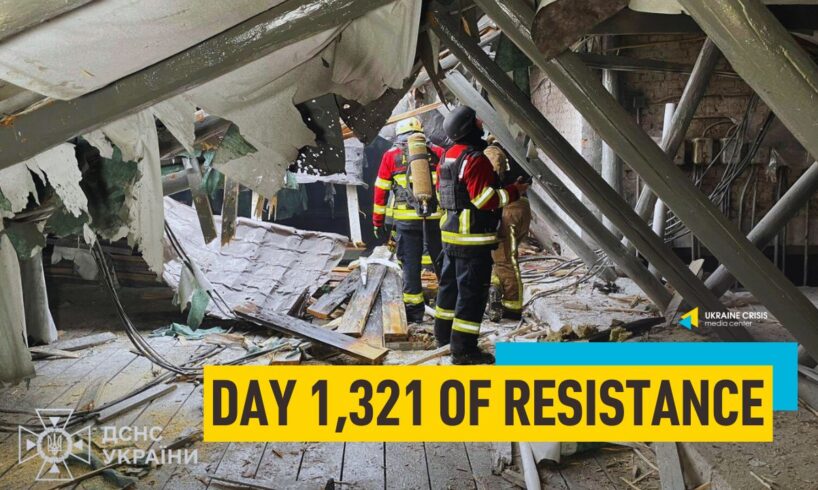
A Russian drone strike hit a perinatal center in Sumy. Ukraine has started striking Russia’s energy sites with its own Flamingo missiles, The Economist says. The Ukrainian navy assumes a key role during NATO’s REPMUS/DYMS exercises in Portugal.
Russian drone strike hits perinatal center in Sumy
A Russian drone strike caused a fire on the roof of a perinatal center in the city of Sumy, head of the Office of the President of Ukraine, Andriy Yermak said in a post to social media Monday. No injuries or fatalities were reported.
In the moment of the attack, 11 children, 35 female patients and 120 staff workers were inside, Yermak said. “Everyone has managed to go down to take shelter. The attack continues,” he added.
Head of the Sumy regional military administration, Oleh Hryhorov, said Russia carried out a deliberate drone strike on a medical facility in the city’s Kovpakivskyi district. There were 166 people at the moment of the attack, he added.
The city of Sumy and the surrounding region are a target for Russia’s daily attacks. A drone strike on passenger trains in Shostka on Saturday killed one person and injured at least 30 others.
Ukraine has started striking Russia’s energy sites with own Flamingo missiles, The Economist says
Ukraine has started using domestically produced Flamingo cruise missiles to inflict damage on Russia’s energy infrastructure, The Economist said on Sunday. The country currently manufactures two or three of these missiles a day, but that number is expected to rise to seven later this month. The paragraphs below are quoted from the article.
There are also reports that FP-5 “Flamingo” cruise missiles have begun to be used [in the strikes – edit.]. They are much faster than the drones, flying just 50 metres above the ground, with a range of over 3,000km and packing a huge punch thanks to a 1,150kg warhead.
If the FP-5 proves capable of penetrating Russian air defences it will bring a new level of destructiveness to Ukraine’s DeepStrike campaign.
Its range allows it to fool defences by flying on constantly changing vectors towards its target.
To make the FP-5 Fire Point [the company manufacturing the missile – edit.] uses repurposed Soviet-era turbofan engines, and its carbon-fibre fuselage takes just six hours to produce.
Fire Point is currently making two or three of the FP-5s a day, but that number is expected to rise to seven later this month.
Each cruise missile costs about $500,000.
By contrast, an American Tomahawk missile costs four times that, has a shorter range and carries a much lighter payload, though it is probably more accurate and harder to shoot down.
Although the one-way attack drones the Ukrainians are using fly relatively slowly and carry warheads of only between 60 and 120kg, they have the range and the accuracy to do serious damage.
About 60% of the deep strikes on Russian territory are carried out by Ukrainian Fire Point FP-1 drones, which with a smaller payload can reach targets 1,500km within Russia and have sophisticated software that has proved resistant to intense electronic-warfare jamming.
But critically, notes Olena Kryzhanivska, an expert on Ukrainian weapons systems, the FP-1s cost only about $55,000 each and are now being churned out at a rate more than 100 a day.
Ukraine is also using the heavier and more expensive Lyutyi drone, which has a range of 2,000km, and a battle-tested machine-vision system to guide it to its target.
In the past week or so, Ukraine has badly damaged a big oil export terminal at Novorossiysk on the Black Sea, a refinery complex in Bashkortostan (over 1,300km from Ukraine), and a pumping station in Chuvashia, 1,000km away. A major refinery in Yaroslavl was hit on October 1st.
About 40 percent of Russia’s oil-refining capacity has been taken out following Ukraine’s attacks, The Economist said.
Benedict George, head of European oil-product pricing at Argus Media, an energy-market intelligence firm, says that Ukraine has hit 16 out of 38 Russian oil refineries.
Mr George says that diesel exports are as much as 30% lower than a year ago and are at their lowest since 2020.
The Flamingo FP-5 long-range cruise missile, developed by Ukraine’s Fire Point defense company, is capable of traveling 3,000 kilometers. Its photo was released in mid-August by AP photographer Yefrem Lukatskyi. Ukrainian President Volodymyr Zelenskyi said in late August that he hopes the Flamingo will be mass-produced early next year.
Ukrainian navy assumes key role during NATO’s REPMUS/DYMS exercises in Portugal
For the first time in NATO’s history, Ukraine’s Navy led and coordinated the Opposing Force (OPFOR) during REPMUS/Dynamic Messenger 2025 exercises in Portugal, the General Staff of the Ukrainian Armed Forces said Monday.
The training highlighted modern maritime warfare trends, particularly the use of unmanned systems for coordinated strikes and rapid threat response. In this strategic step forward, Ukraine’s leadership brought combat realism to the exercise, driving innovation and the development of new NATO tactics, NATO’s Allied Maritime Command said.
“The operational staff of the Ukrainian Navy organized joint work on planning and managing the opposing forces from Ukraine and partner countries participating in the training operations as part of OPFOR. The joint exercises involving the Ukrainian Navy were conducted successfully,” the Ukrainian General Staff said in a statement.
This year’s exercises combined REPMUS, the world’s leading event in maritime robotics and unmanned technologies, with Dynamic Messenger (DYMS), which is part of NATO’s series of operational exercises.
Brigadier General Wojciech Ozga, Commander of the NATO-Ukraine Joint Analysis, Training and Education Centre (JATEC) said as per a statement released by Ukraine’s General Staff: “By leading the opposing team, Ukraine is not only a participant but also a driving force for innovations that directly strengthen NATO’s maritime resilience and shape the future of collective security. JATEC is proud to contribute to this important advancement.”
During the exercises, unmanned platforms were integrated with the DELTA situational awareness system, which is in use with the Ukrainian Armed Forces.
Colonel Valeriy Vyshnevskyi, Director of Programme Implementation at the NATO-Ukraine Joint Analysis, Training and Education Centre (JATEC) said as cited by the General Staff: “Ukraine’s participation in the exercises is a unique opportunity to demonstrate key trends in modern naval warfare. We add the realism of contemporary combat to NATO exercises, which should further encourage the Alliance to implement innovative changes and tactics in maritime operations.”
Along with Ukraine, the REPMUS/DYMS-2025 exercises involved forces and assets from the Naval Forces, enterprises, and research centers of 26 partner countries, the statement reads.





